Aba Therapy Techniques for Autism
Harnessing Science to Improve Lives: Effective ABA Strategies for Autism

Understanding ABA and Its Role in Autism Intervention
Applied Behavior Analysis (ABA) is a scientifically validated approach used extensively to support individuals with autism spectrum disorder (ASD). Rooted in the principles of learning and behavior, ABA aims to promote meaningful improvements across various developmental domains while reducing behaviors that hinder progress. This comprehensive overview explores what ABA therapy involves, the specific techniques utilized, how it addresses behavioral challenges, and how parents and practitioners can access or implement these methods effectively.
What is ABA Therapy and How Does It Work for Autism Treatment?
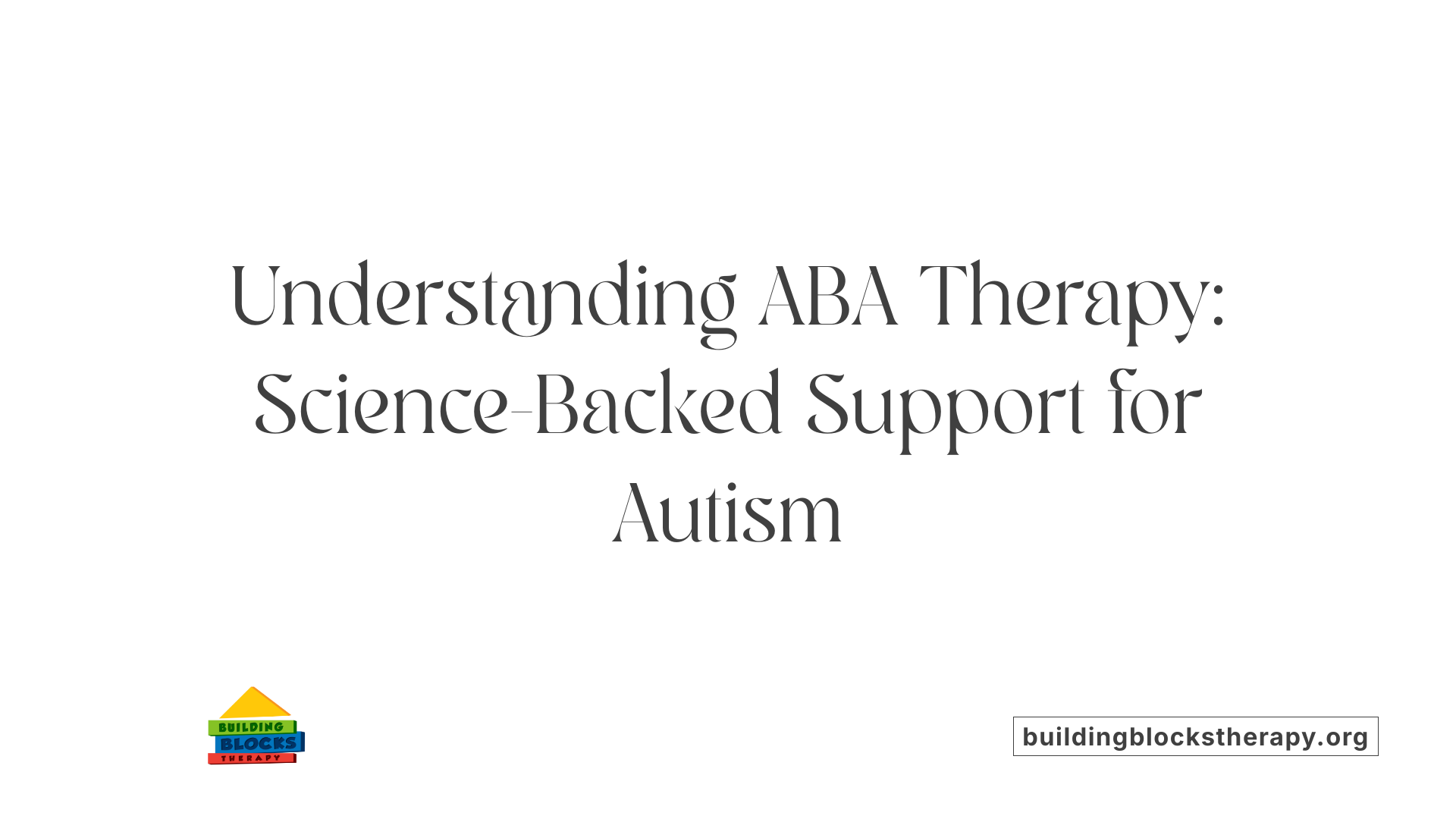
What is ABA therapy and how does it work for autism treatment?
Applied Behavior Analysis (ABA) is a scientific and evidence-based approach used to support individuals with autism spectrum disorder (ASD). It is rooted in the science of learning and behavior, analyzing how environmental factors influence actions. ABA aims to promote helpful behaviors and reduce any that are harmful or impede daily functioning.
The core of ABA involves understanding the relationships between antecedents (triggers), behaviors, and consequences—often called the ABCs. By identifying these components, therapists can effectively modify behavior patterns.
ABA therapy is highly personalized. A qualified behavior analyst, often a Board Certified Behavior Analyst (BCBA), assesses each individual’s unique needs and creates a tailored intervention plan. These plans focus on specific goals related to communication, social skills, self-care, academic abilities, and motor skills.
Many techniques are employed within ABA, including Discrete Trial Training (DTT), which involves structured, step-by-step tasks with rewards for desired responses. Natural environment teaching adapts ABA strategies to everyday settings, boosting the generalization of skills.
Positive reinforcement is essential in ABA. It involves rewarding wanted behaviors to encourage their recurrence, while negative reinforcement removes unpleasant stimuli to achieve the same goal. Other methods include prompting, modeling, and behavior chaining, which break down complex skills into manageable steps.
Attention is also given to data collection and ongoing assessment. Regular monitoring helps track progress, allowing therapists to adjust strategies for maximum effectiveness.
Research consistently supports ABA’s effectiveness. As an evidence-based practice backed by organizations such as the US Surgeon General and the American Psychological Association, ABA has demonstrated significant improvements in communication, social interactions, problem behaviors, and learning abilities.
Overall, ABA aims to foster independence and enhance quality of life by teaching functional behaviors that enable children and adults with autism to participate more fully in their communities.
How do personalized intervention plans play a role?
Intervention plans in ABA are designed specifically for each person. The process begins with a functional assessment, where a BCBA observes and evaluates the individual's behaviors and skills. Results guide the development of a plan that sets clear, measurable goals.
These plans can target a broad range of skills, such as language development, social interactions, self-care routines, and academic skills. They are flexible and adaptable based on progress and changing needs.
What are the goals for improving communication, social, and adaptive skills?
Goals often include enhancing verbal and non-verbal communication, increasing social engagement, and developing independence in daily routines. For example, teaching a child to initiate conversation, share toys, or complete tasks without prompts.
What does evidence say about ABA’s effectiveness?
Numerous studies show that between 63% and 88% of research on ABA report positive outcomes. Improvements have been noted across multiple domains, such as cognitive ability, language skills, social interactions, problem behaviors, and adaptive daily skills.
However, many of these studies are small in scale, often involving few participants, emphasizing the need for larger, more comprehensive research.
Despite these limitations, ABA remains the most supported behavioral intervention for autism, with its principles integrated into many programs worldwide.
| Aspect | Key Details | Additional Notes |
|---|---|---|
| Methodologies | DTT, PRT, ESDM, natural environment teaching | Different techniques suited for ages and needs |
| Behavioral Focus | Reinforcement, modeling, prompting, chaining | Encourages learning by doing |
| Goals | Communication, social skills, independence, academic skills | Wide-ranging, individualized targets |
| Evidence | Strong support by research and organizations | Need for more long-term, large-scale studies |
Through tailored strategies and ongoing measurement, ABA strives to improve everyday functioning and foster meaningful progress for individuals with autism.
Specific Techniques and Methods in ABA for Autism
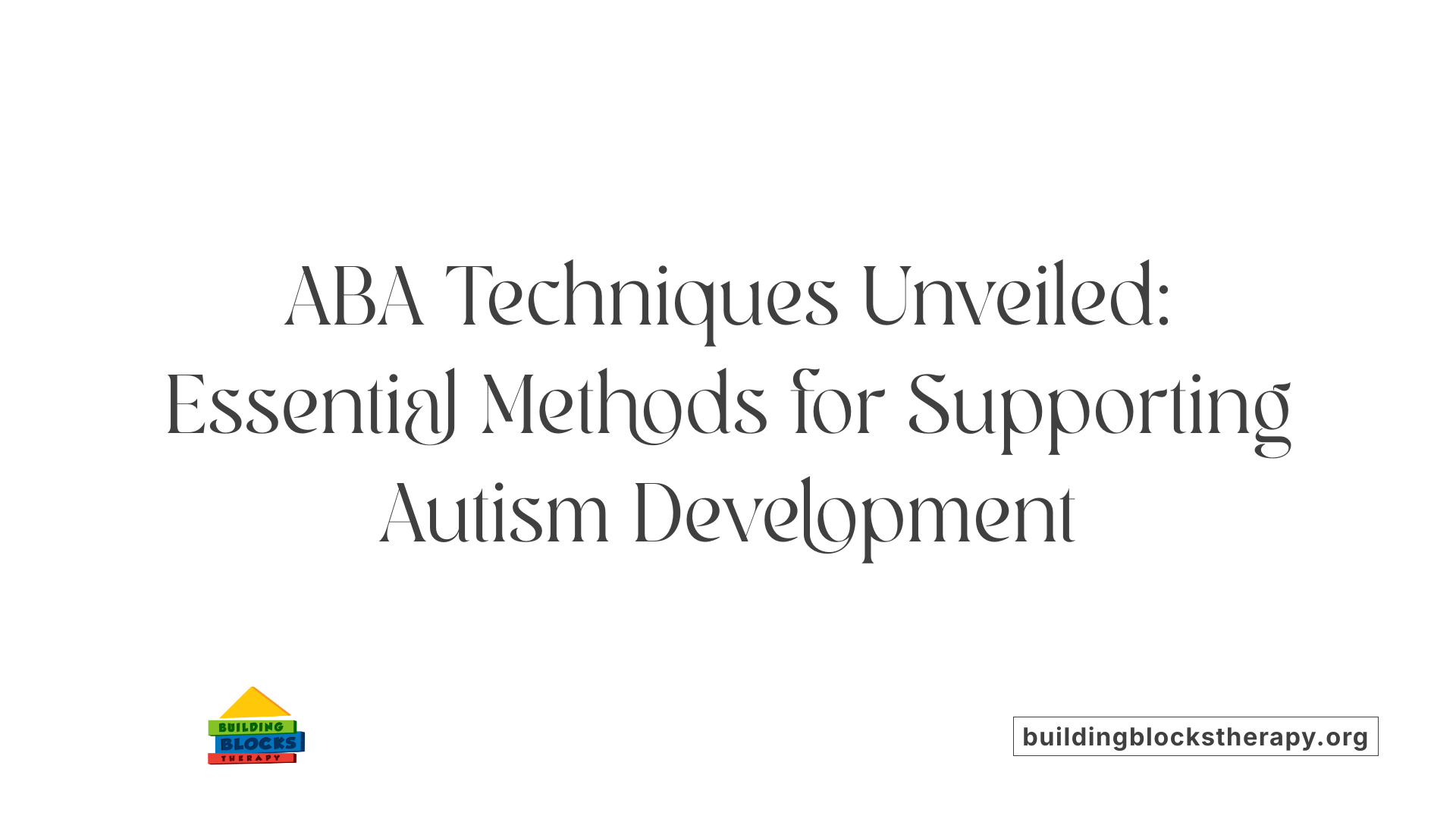
What specific techniques and methods are used in ABA therapy for autism?
Applied Behavior Analysis (ABA) employs a wide range of strategies to promote positive behavior changes and skill development for individuals with autism. These methods are evidence-based and tailored to each person's needs, ensuring effective and meaningful outcomes.
One foundational technique is Discrete Trial Training (DTT). DTT offers structured, repetitive teaching opportunities in a controlled environment. It involves presenting a clear instruction or prompt, waiting for the individual's response, and providing reinforcement or correction based on their response. This method is effective for teaching specific skills like language or social responses.
Natural Environment Teaching (NET) shifts the focus from structured sessions to everyday settings. It encourages learners to practice skills in natural situations, such as at home, in the park, or in the community. This approach helps children generalize skills across different environments, making them more functional and relevant.
Behavior chaining is another critical approach, especially for teaching complex tasks. It involves breaking down a task into smaller, manageable steps. Each step is taught sequentially, with reinforcement provided as the individual completes each part. Once all steps are mastered, the chain is combined into a complete, smooth activity.
Modeling and video modeling are visual techniques that aid learning. Live modeling demonstrates desired behaviors through an adult or peer performing the task. Video modeling uses videos that showcase appropriate behaviors or social interactions for individuals to watch and imitate. These methods are particularly useful for teaching communication, social skills, and emotional expression.
Reinforcement strategies are central to ABA. Positive reinforcement involves rewarding desirable behaviors to increase their occurrence, such as giving praise, tokens, or preferred items. Negative reinforcement involves removing unpleasant stimuli when a specific behavior occurs, encouraging its repetition. Conversely, reinforcement systems and behavior contracts can be used to set clear expectations and motivate skill acquisition.
Prompting and fading are techniques used to teach new behaviors. Prompts, like gestures or verbal cues, guide the learner towards the desired response. Over time, these prompts are faded—gradually reduced—to promote independent performance without external cues.
Behavior contracts are written agreements that specify expected behaviors and associated rewards. They are often used with older children or in structured settings to reinforce positive behaviors through clear, mutual understanding.
Extinction involves stopping reinforcement for challenging behaviors. This method aims to reduce undesirable behaviors over time by removing the reinforcement that maintains them. It requires consistency and patience, as initial repetitions of the behavior may increase before diminishing.
Redirection is a proactive technique that guides attention away from problematic behaviors toward more positive options. It's especially useful for managing disruptive behaviors in real-time by focusing the individual on engaging activities or alternative responses.
These techniques, used singly or in combination, create a flexible and responsive ABA program tailored to individual goals. Continuous data collection and assessment ensure that interventions are effective and adjusted as needed for optimal progress.
Addressing Behavioral Challenges in Autism with ABA
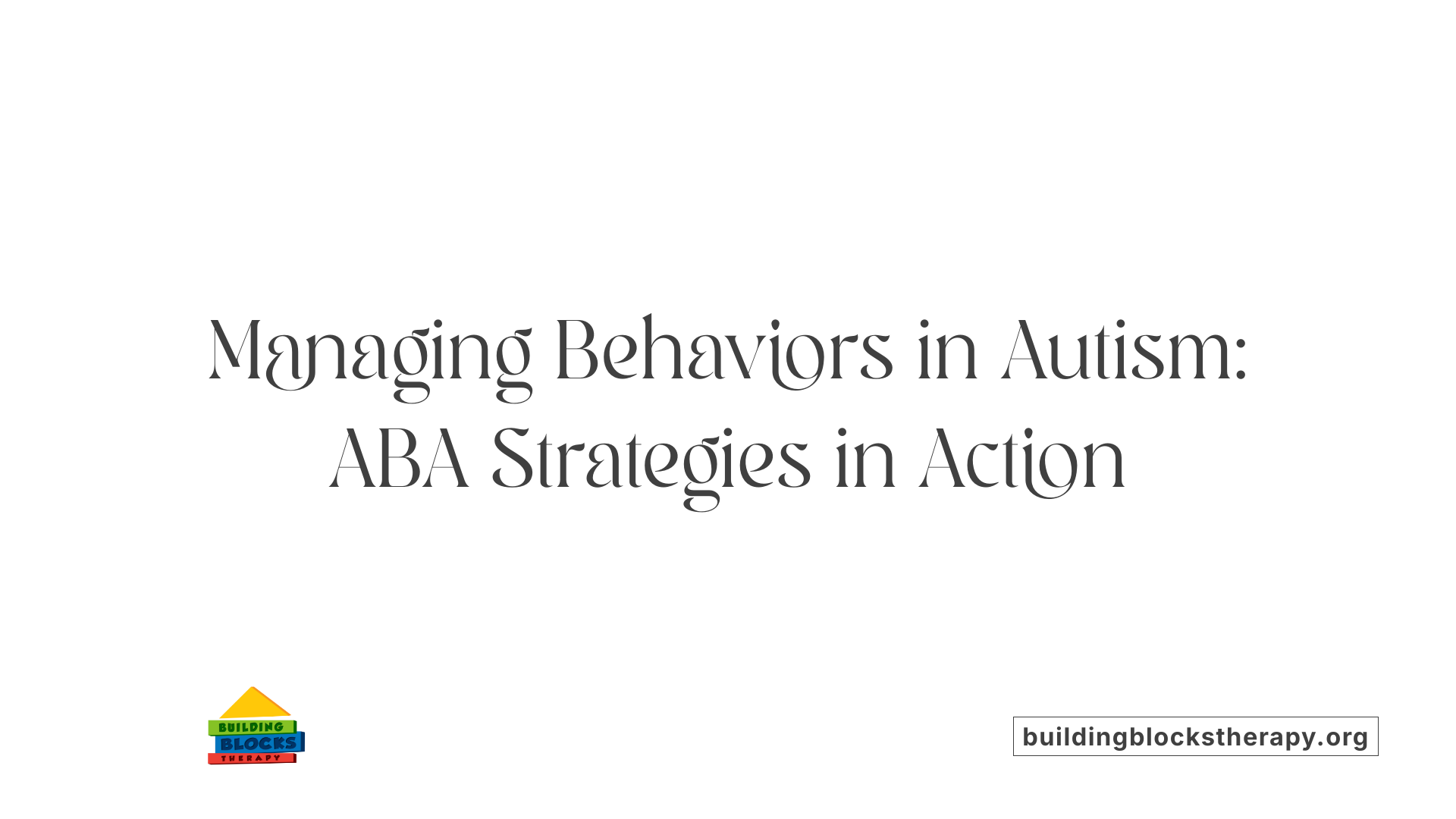
How does ABA therapy address behavioral challenges in autism?
Applied Behavior Analysis (ABA) offers a structured way to understand and manage behaviors in children and youth with autism. Central to ABA is the ABC model—Antecedent, Behavior, and Consequence—which helps identify what triggers a behavior, the behavior itself, and what happens afterward that may reinforce it.
By examining these components, therapists develop individualized plans that target specific behaviors. For example, if a child becomes disruptive when asked to transition between activities, ABA techniques can help identify the antecedent (the transition cue), and implement strategies such as visual supports or prompting to make the transition smoother.
Reinforcement plays a pivotal role in shaping behavior. Desirable behaviors like communication and social interaction are encouraged through positive reinforcement—offering rewards or praise that the child finds motivating. Conversely, less helpful behaviors, such as self-injury or aggression, are reduced by applying response interruption, response cost, or extinction methods (ceasing reinforcement for these behaviors).
ABA sessions are carefully data-driven, with progress continuously monitored through detailed record-keeping. This approach ensures modifications are based on measurable outcomes, making interventions precise and efficient.
What strategies are used for functional communication?
One key goal of ABA is enhancing communication skills, often through methods like functional communication training (FCT). FCT teaches children alternative ways to express needs, wants, or feelings to reduce frustration-induced behaviors. For instance, a child who bites when hungry might be taught to use picture exchange systems or verbal requests instead.
Visual supports and prompts are integral to this process. Visual aids—charts, pictures, and videos—help children understand routines, expectations, and appropriate behaviors. Prompts—such as verbal hints, gestures, or physical cues—are used initially to guide the execution of skills. Over time, prompts are systematically faded out to promote independence.
What are common behavior modification techniques?
ABA uses various methods to modify behavior effectively:
- Shaping: Reinforcing successive approximations towards a desired behavior.
- Response Replacement: Encouraging alternative, appropriate responses to replace undesired behaviors.
- Behavior Chaining: Breaking down complex tasks into smaller, teachable steps.
- Modeling: Demonstrating behaviors through live examples or videos.
- Redirection: Redirecting attention from disruptive behaviors to positive activities.
- Script Fading: Providing verbal scripts to improve social interactions.
- Extinction: Removing reinforcement from problematic behaviors to diminish their frequency.
Each technique is selected based on the individual child's needs, ensuring interventions are respectful and effective.
How is data used to inform intervention plans?
Data collection is fundamental to ABA. Practitioners record each session’s details—what behaviors occurred, what triggers were present, and what consequences followed. This information helps assess whether strategies are working and guides necessary adjustments.
Regular assessment enables therapists to set measurable goals and track progress accurately. If a child’s communication skills improve with a specific prompt, the plan can be refined to include more of those prompts, or to introduce new goals.
This continuous cycle of data collection, assessment, and modification ensures tailored, adaptive interventions that grow with the child's development.
| Aspect | Techniques Used | Purpose | Outcomes |
|---|---|---|---|
| Behavior Understanding | ABC analysis | Identify triggers and reinforcers | Customized plan development |
| Communication Skills | FCT, visual supports, prompting | Improve expression and reduce frustration | Enhanced interaction and independence |
| Behavior Modification | Shaping, chaining, modeling, redirection | Reduce harmful or disruptive behaviors | Safer environment, better social skills |
| Data Monitoring | Regular tracking and assessment | Make informed adjustments | Increased effectiveness of interventions |
By integrating these approaches, ABA provides a comprehensive framework for managing behavioral challenges, ultimately improving the daily lives and social participation of children with autism.
Guidance on Finding and Implementing ABA Services and Techniques
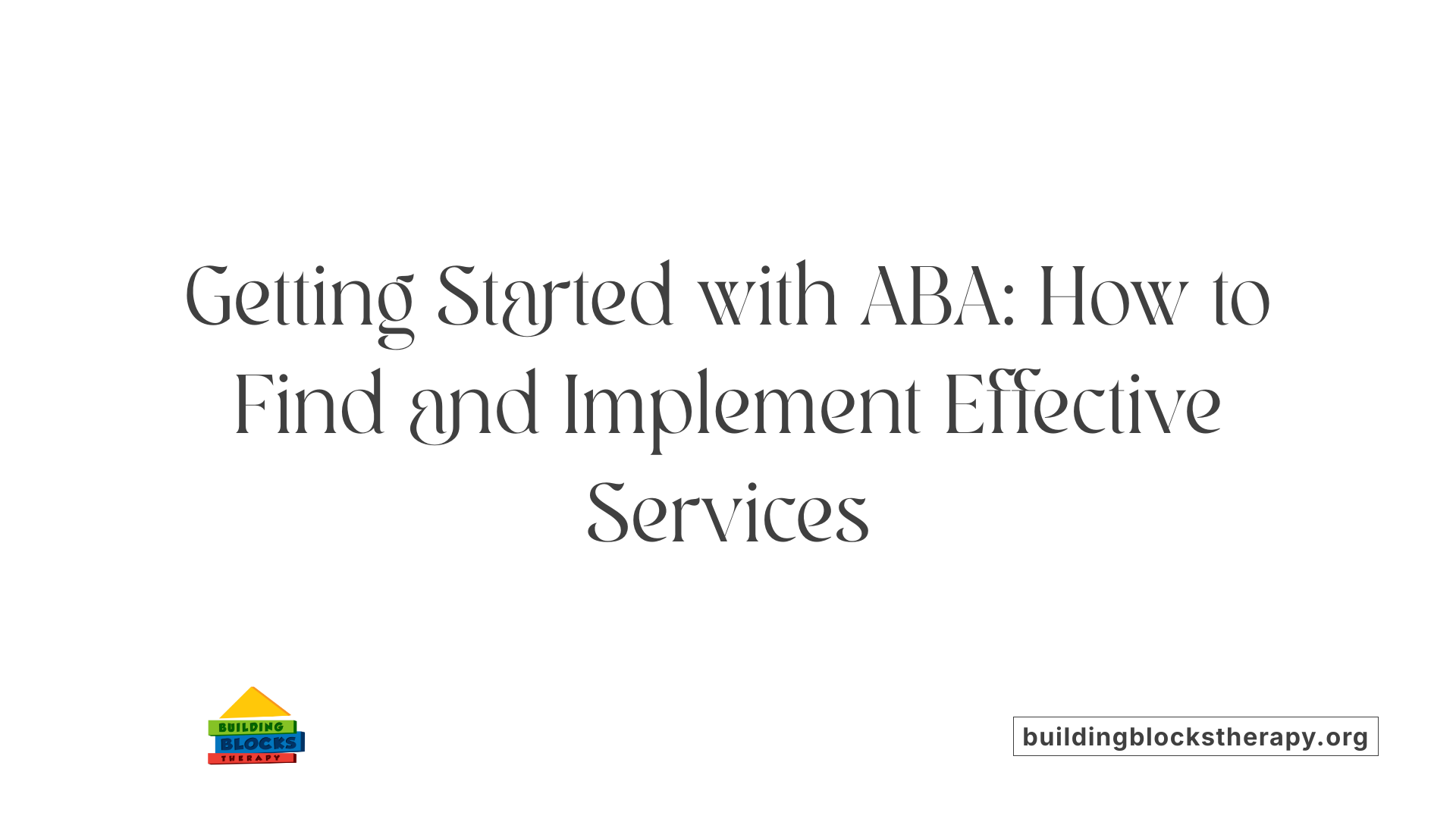
How can one find or implement ABA services and techniques?
Beginning the journey with ABA therapy typically involves consulting a qualified professional known as a Board Certified Behavior Analyst (BCBA). These experts specialize in assessing individual needs and designing tailored treatment plans that harness the evidence-based practices of ABA.
A BCBA conducts comprehensive assessments to identify behaviors that need reinforcement or reduction. Based on this evaluation, they develop customized programs targeting critical skills such as communication, social interaction, academic abilities, and self-care. These programs often utilize techniques like positive reinforcement—rewarding desirable behaviors—and the ABC approach, which examines antecedents, behaviors, and consequences to modify responses effectively.
ABA services can be accessed through several avenues. Many families turn to licensed clinics that offer specialized programs. Private practitioners and educational settings also provide ABA-based interventions, ensuring a broad range of options suited to different needs and preferences.
Implementing ABA at home complements professional therapy. It requires creating a structured environment where consistent routines, visual supports such as charts or pictorial cues, and reinforcement strategies are in place. Parents and caregivers are encouraged to learn and apply techniques like prompting, behavior chaining, and redirection to promote skill generalization and independence.
Regular monitoring is vital. This involves ongoing data collection to track progress, evaluate the effectiveness of interventions, and make adjustments as necessary. Close collaboration with trained therapists ensures that the strategies remain aligned with developmental goals and adapt to changing needs.
Ensuring that providers are credentialed and experienced enhances the quality of care. Working closely with qualified professionals allows for a comprehensive approach that maximizes the benefits of ABA therapy, fostering meaningful improvements in behavior, communication, and social skills.
Scientific Evidence and Effectiveness of ABA in Autism
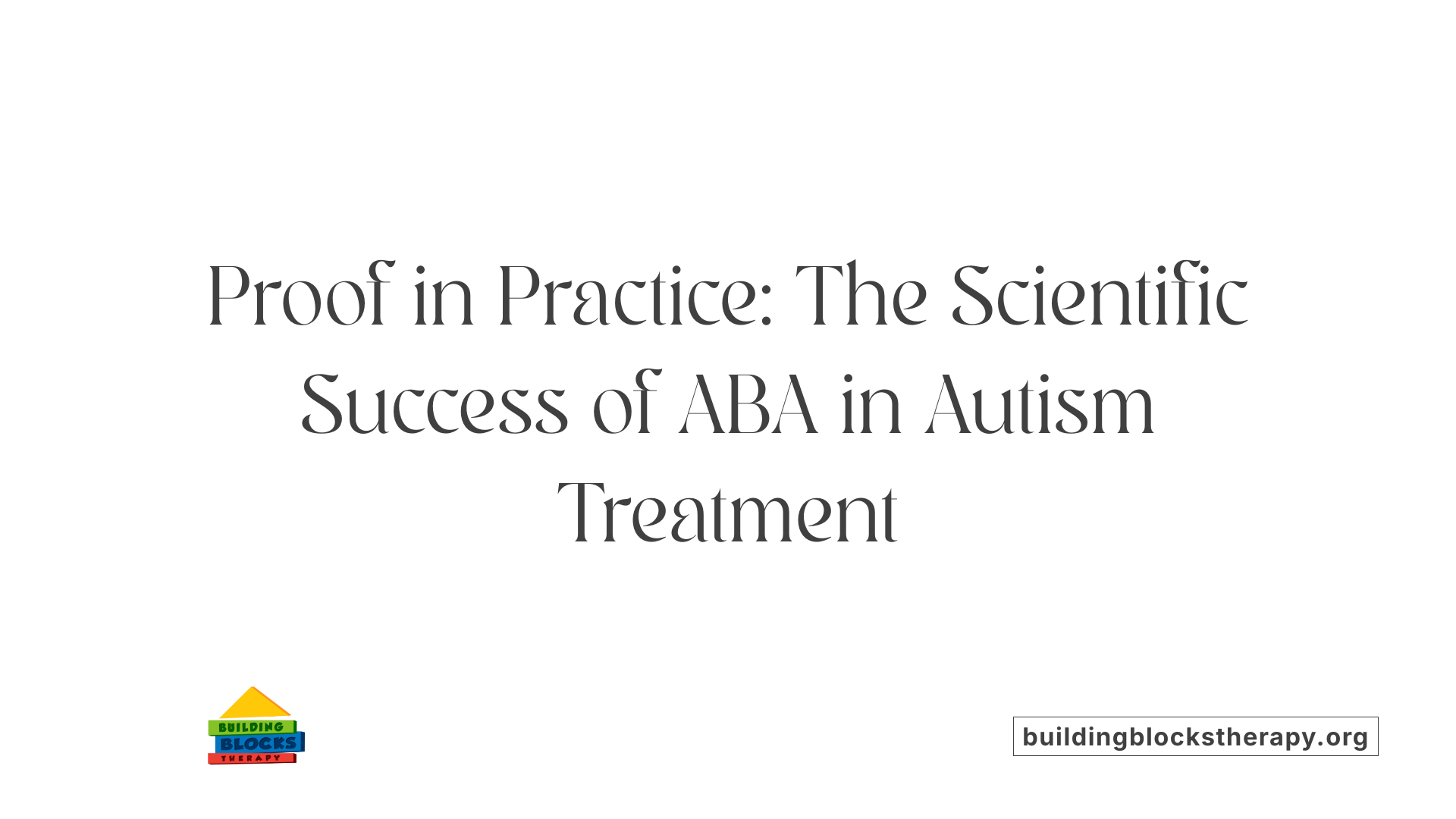
What is the evidence for the effectiveness of ABA therapy in autism?
Research over several decades provides substantial support for ABA therapy as an effective intervention for children with autism spectrum disorder (ASD). Numerous controlled studies, some involving large sample sizes such as 60 children, have consistently shown that ABA can lead to meaningful improvements in core developmental skills.
These studies highlight that early and intensive ABA programs tailored to individual needs can significantly enhance language acquisition, social skills, and daily living abilities. For example, children who receive more than 20 hours of ABA therapy during their early years often demonstrate larger developmental gains, including better language use and increased independence.
In addition to promoting skill development, ABA has been proven to reduce problematic behaviors like self-injury and aggression. These findings have been confirmed by research studies since the 1960s, establishing ABA as a scientifically supported treatment.
Organizations such as the US Surgeon General and the American Psychological Association recognize ABA as an evidence-based best practice for treating autism. It employs a variety of techniques, including discrete trial training, pivotal response treatment, and the Early Start Denver Model, which integrate structured teaching with naturalistic exchanges.
Meta-analyses and systematic reviews
Meta-analyses and systematic reviews of ABA research consistently reinforce its effectiveness. Most reviews report that between 63% and 88% of studies observe positive outcomes, particularly in communication, social skills, and problem behavior reduction.
However, despite robust evidence supporting immediate and short-term improvements, these reviews highlight the need for more high-quality, long-term studies to evaluate sustained benefits and overall quality of life.
Long-term benefits and developmental gains
Early implementation of ABA—especially starting before age three—can lead to significant developmental progress. Children often show improvements across multiple domains, including adaptive behaviors, emotional regulation, and reduction in autism symptoms.
These benefits contribute to greater independence and better social integration as children grow, ultimately improving their overall quality of life. Evidence suggests that gains made through ABA can extend well into adolescence and adulthood, emphasizing the importance of early intervention.
Limitations and future research needs
Despite the strong body of evidence supporting ABA, there are notable gaps in the research. Many studies involved small sample sizes and single-case experimental designs, which can limit the generalizability of findings.
Only about 4% of studies compare ABA directly with other interventions or control groups, underscoring the need for larger, randomized controlled trials. Further research should focus on long-term outcomes, including how ABA impacts quality of life, employment, and emotional well-being.
Additionally, there is a call for studies that evaluate the sustainability of ABA gains, as well as its effectiveness when implemented in diverse settings and populations.
| Aspect | Current Evidence | Future Needs | Example of Focus |
|---|---|---|---|
| Study Types | Small samples, SCEDs, some large sample studies | Larger, randomized, controlled trials | Long-term benefits, societal outcomes |
| Outcomes Measured | Skills acquisition, problem behavior reduction | Quality of life, employment, mental health outcomes | Impact across lifespan, adult independence |
| Generalizability | Limited due to small samples and specific designs | Broader, diverse populations in various settings | Effectiveness in different cultural and socioeconomic groups |
Overall, the scientific evidence strongly endorses ABA's effectiveness, though ongoing research is essential to expand understanding, improve methods, and enhance long-term outcomes for individuals with autism.
Integrating ABA with Other Interventions and Considerations for Optimal Outcomes
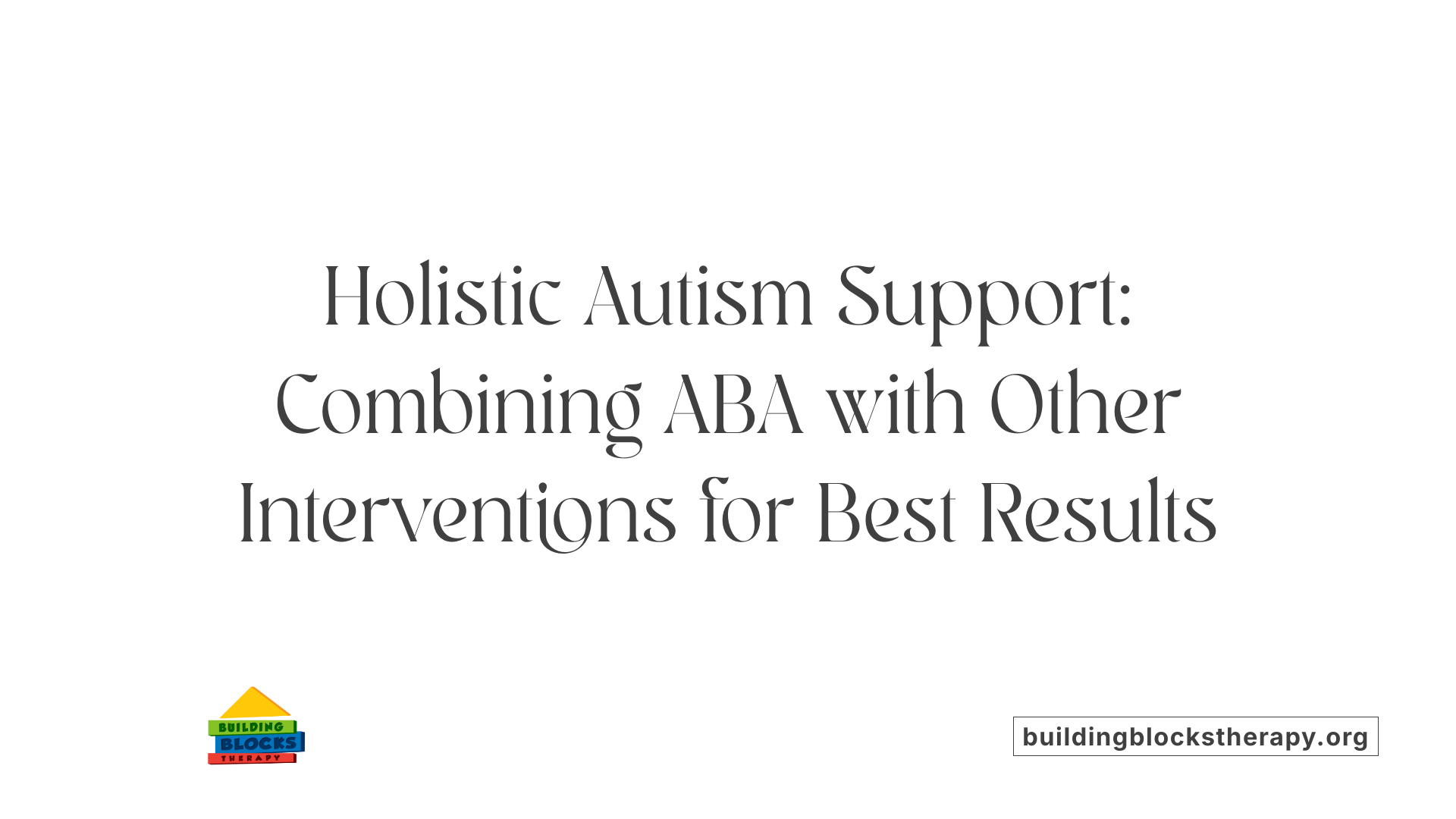
What is the evidence for the effectiveness of ABA therapy in autism?
Research supports that Applied Behavior Analysis (ABA) is a scientifically validated approach for improving skills in children with autism spectrum disorder (ASD). Multiple large-scale studies, including those involving around 60 children, have documented significant progress in social interaction, communication, and daily living skills after ABA interventions.
Early and individualized ABA programs tend to yield the best outcomes, with children showing notable improvements in language, adaptive behaviors, and social engagement. These positive effects are reinforced by the fact that organizations like the US Surgeon General and the American Psychological Association recognize ABA as an evidence-based treatment.
Since the 1960s, ABA has been extensively studied and refined. Evidence indicates it not only boosts functional skills but also effectively reduces harmful behaviors such as self-injury. The flexibility of ABA allows it to be tailored to each child's unique needs, making it a cornerstone of effective developmental support. Overall, scientific research consistently confirms ABA’s role in improving quality of life, fostering independence, and supporting social participation in children with ASD.
Complementary and alternative therapies
While ABA remains the gold standard in behavioral intervention, many families explore additional options. Complementary and alternative therapies such as sensory integration therapy, special diets, herbal supplements, animal-assisted therapy, arts therapy, mindfulness, and relaxation techniques are often used alongside ABA. These approaches may provide emotional comfort, sensory regulation, or social engagement, but they are generally considered supplements rather than replacements. It is important to consult with healthcare professionals to integrate these therapies safely.
Developmental and educational approaches
Beyond ABA, developmental strategies such as the Early Start Denver Model (ESDM) are designed specifically for young children (12–48 months). ESDM incorporates play and social exchanges in natural settings, targeting language, social skills, and cognitive development.
Educational models like TEACCH emphasize visual learning, routines, and structured environments to support children’s understanding and independence. Social-relational methods—including DIR/Floor Time, RDI, Social Stories, and social skills groups—focus on building emotional bonds, social thinking, and emotional regulation.
Medication and mental health support
Currently, there are no medications that treat the core symptoms of ASD directly. However, medications may be prescribed to manage associated conditions such as anxiety, hyperactivity, or seizures. Psychological therapies like cognitive-behavioral therapy (CBT) are also employed to address mental health concerns, helping children and adolescents process emotions and develop coping skills.
Holistic and family-centered approaches
Effective autism support emphasizes a holistic, family-centered model. This approach recognizes the importance of the家庭’s role and prioritizes family involvement in treatment plans. Family training, support groups, and counseling can help caregivers implement strategies consistently and cope with challenges.
Multidisciplinary teams—including behavior analysts, speech and occupational therapists, psychologists, and medical professionals—collaborate to develop personalized, comprehensive plans. This coordinated effort ensures that interventions are balanced, addressing developmental, behavioral, emotional, and medical needs.
Importance of individualized, multidisciplinary plans
A cornerstone of successful autism intervention is the development of individualized, multidisciplinary plans. These plans are crafted based on thorough assessments and tailored to each child's strengths, challenges, and family circumstances.
Regular monitoring and adjustments are essential, employing data collection to track progress. Interdisciplinary collaboration ensures the integration of behavioral, developmental, educational, medical, and family supports, fostering a cohesive environment for growth.
| Aspect | Approach | Focus | Benefits |
|---|---|---|---|
| Behavioral | ABA, DTT, PRT, ESDM | Skill acquisition, behavior reduction | Evidence-based, adaptable, comprehensive |
| Developmental | DIR/Floor Time, RDI | Social-emotional development | Enhances emotional bonds, social thinking |
| Educational | TEACCH, visual routines | Learning and independence | Structured, visually supported learning |
| Medical & Mental | Medications, CBT | Co-occurring conditions | Symptom management, emotional regulation |
| Family & Holistic | Parent training, support | Family well-being, consistency | Empowerment, better outcomes |
Ultimately, combining these approaches within a personalized, team-based plan maximizes the potential for meaningful progress and an improved quality of life for individuals with autism.
Bringing It All Together: The Power of ABA in Autism Support
ABA therapy remains a cornerstone in autism intervention, proven by extensive scientific research to enhance communication, social skills, and daily functioning. Its flexible techniques and personalized programs allow effective management of behavioral challenges, fostering greater independence and life quality. Collaborating with trained professionals and understanding the core principles of ABA can empower families and caregivers to implement strategies at home and access comprehensive services. As ongoing research continues to refine methods and expand understanding, ABA’s role in supporting individuals with autism remains both vital and evolving, representing a beacon of hope for meaningful development and inclusion.
References
- Applied Behavior Analysis (ABA)
- ABA Techniques: Strategies for Behavior Analysts - GSEP Blog
- ABA Therapy Examples, Definition & Techniques
- Applied Behavior Analysis in Children and Youth with ...
- Treatment and Intervention for Autism Spectrum Disorder
- Understanding ABA Techniques: 7 Strategies You Need to ...
- Applied Behavior Analysis (ABA)
- The effectiveness of applied behavior analysis program ...
- The Controversy Around ABA






